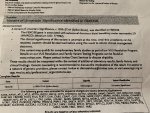I don't have ME/CFS, its not a diagnosis in the US and especially for Kaiser Permanente HMO that I'm a member of.
What I have is an unknown non-inflammatory myopathy in my right leg found by muscle biopsy in 2014, the year I joined this forum.
The working diagnosis is necrotizing autoimmune myopathy and ritux is one of the main drugs of choice for NAM.
I've already done ivig and methotrexate the past few years, ritux has helped the most.
NAM was almost unknown when I was diagnosed, Dr Christopher-Stine at John Hopkins led research into it when statin users started getting muscle damage after stopping statin drugs.
This also reminds me of my Invitae myopathy and nuero panel lab tests I had done in 2017 and 2018 by Kaiser.
I had several variants of unknown significance, for one of them the FBXO38 gene my test results made it into the NCBI Clinvar database.
With the muscle loss and now spinal issues starting to appear I am wondering if this is the actual disease.
Unfortunately until there is further research into this gene I won't know, thats why its a VUS.
https://www.ncbi.nlm.nih.gov/clinvar/RCV000651190/
If you click on the evidence tab this is what my test results state.

